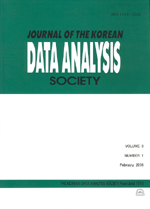VaR 기법을 이용한 KOSPI의 실효성 연구
A Study on Effectiveness of KOSPI using VaR Method
- 한국자료분석학회
- Journal of The Korean Data Analysis Society (JKDAS)
- Vol.14 No.5
-
2012.102477 - 2485 (9 pages)
- 12

본 논문은 주식 및 선물시장에서 미래의 변동과 수익성에 대한 충분한 대비가 필요하다는 견지에서 2010년과 2011년의 KOSPI에 대하여 위험통제 방법론 중 하나인 market VaR를 이용한 실증분석을 실시하고, 미래의 위험을 통제하기 위한 VaR 방법론이 KOSPI에 대해서도 효용성이 있는지에 대해 논의하였다. 2010년과 2011년의 KOSPI에 대한 95% VaR 모형 적용결과 설정한 신뢰구간에 비하여 VaR 값이 낮게 형성되는 것으로 나타났다. 또한 금융시장이 변곡점을 형성하는 시기에는 VaR가 표준편차보다 증가하는 형상이 나타나며, 이로 인해 KOSPI가 상승 또는 하락하는 시점에서 또 다른 박스권을 형성하는 것으로 나타났다. 이러한 결과는 박스권 내에 머무는 기간이 대체로 장기인 경우 평균 주가 수렴도가 낮게 나타나는 것으로 볼 수 있다. 실증분석 결과 VaR 방법론이 포트폴리오의 위험을 완벽하게 설명할 수는 없으나, 80% 이상의 통계적 유의성은 가진다고 볼 수 있다.
Value at Risk (VaR) is one of the most popular tools used to estimate exposure to market risks, and it measures the worst expected loss at a given confidence level. In this paper, we applied to the VaR to control for the risk of future and discussed the effectiveness of the VaR in the Korea composite stock price index (KOSPI). In 2010 and 2011 year of the KOSPI, 95% VaR model was applied .The results showed that VaR values were lower than the 95% confidence interval and when the financial markets form the inflection point appears, VaR shapes are higher than the standard deviation. As a result, when the KOSPI was rising or falling, VaR formed to different trading range and when the trading range is long-term, VaR is lower than convergence of average stock price. The empirical results are showed that VaR method cannot be completely explained the risk of the portfolio but has a statistical significance of more than 80%.
1. 서론
2. VaR를 이용한 위험측정
3. 실증분석
4. 결론
참고문헌
(0)
(0)